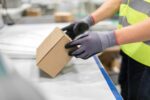
A supply-chain love triangle: a silly concept, to be sure, but with an outcome as disastrous as that involving Helen of Troy, Paris and Menelaus. The delicate nature of the supply chain has been on display over the past year as a result of the pandemic, from toilet paper shortages to the vaccine rollout. By better managing the dynamic interaction among the three main players within the supply chain — logistics, suppliers and buyers — sellers can save money for customers and lessen the environmental impact of the supply-chain industry.
Industrial supply chains serving B2B buyers such as energy, aggregates, agriculture and food processing are key to the economy, and what happens within those networks can have a direct impact on consumers. The food industry is a prime example. When the COVID-19 pandemic struck in 2020, panicked consumers rushed to grocery stores to stock their homes with essentials. However, the increased demand for those products caused stores to experience shortages in key goods — milk being a prime example. At the same time, despite the empty shelves, dairy farmers were forced to dump thousands of gallons of fresh milk.
This is a classic example of a supply-chain breakdown.
What happened? Farmers who were selling to restaurants, hotels and schools no longer had a buyer for their goods. Conversely, grocery stores that needed to buy more products didn’t have access to the suppliers needed to meet the shift in demand. To put it simply, the supplier and buyer relationships were out of sync.
A supply-chain triangle works successfully when the buyer purchases products from the supplier, then either party works with a logistics provider to get the goods delivered to their destination. When communication between the sides of the supply-chain triangle breaks down, waste, stockouts and inefficiencies are the result.
Some common ways that supply chains can fall out of sync include:
- Changing demand. When buyer demand constantly changes, it forces a rewrite of procurement and logistics plans. When these changes don’t happen, it causes trucks to show up at the drop-off location with too much or too little product for the current demand.
- Supplier holdups. When suppliers run out of a product or have long wait times at their location, buyers are forced to purchase the product from elsewhere, then reroute the logistics accordingly.
- Limited trucking capacity. A reduction in trucking capacity forces buyers to acquire additional carriers to make timely delivery of the product.
These are just a few of the hundreds of ways in which a supply chain can become imbalanced.
Such inefficiencies translate into additional costs for each side of the triangle. Shippers that utilize more trucks than needed have higher linehaul and accessorial costs, as well as an increased carbon footprint. On the supplier side, when utilization rates decrease, costs increase. Logistics providers also face the same issue: when the utilization rate of their trucks falls, costs increase, resulting in unsustainable wages and a loss of drivers.
The complex network of suppliers, consumers and carriers can be further complicated by multiple siloed organizations spanning procurement, logistics and operations. The interconnected nature of the network makes it difficult to respond to changes or issues in real time, because once a solution is identified, another solution is needed right away.
The solution to the various issues facing the supply chain lies in artificial intelligence, which has the ability to connect all sides of the triangle.
When all of the sides of a supply-chain triangle are connected end-to-end via A.I.-driven automation, it enables the buyers, suppliers and logistic providers to get back into equilibrium within seconds. By automatically and instantly changing procurement and logistics decisions, every side wins:
- Shipper: Fewer trucks need to be utilized, reducing linehaul and accessorial costs as well as the carbon footprint of logistics consumption.
- Supplier: Utilization rate of the plant increases, reducing costs.
- Logistics provider: Truck utilization rate increases, which reduces costs and allows for higher driver retention and better wages.
Autonomous supply chains are digitally transforming decision making by using A.I. to identify and address inefficiencies in real time, giving users an economic and environmentally sustainable advantage. To build a more resilient supply chain for the modern age, there needs to be increased communication between the three sides of the triangle. A.I. and automation are the one true way to do just that.
Priyesh Ranjan is CEO of Vorto, provider of an A.I.-driven autonomous supply-chain platform.







